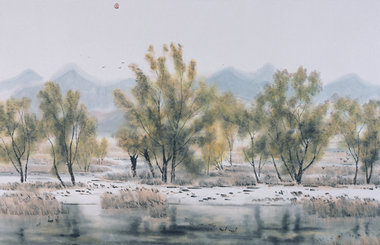Taking flight to NE China
By Chen Liang ( China Daily ) Updated: 2015-04-25 07:32:12
 |
|
A flock of white-fronted geese roost in the paddy field at the Jingxin Wetland in Hunchun in Jilin province. [Photo by Chen Liang/China Daily] |
Northeast China rarely gets many tourists outside of summer, but as Chen Liang discovers, the area's beauty is just as spectacular when the weather is cold.
Few Chinese tourists visit Northeast China in spring, many consider the area too cold and dull before June. That leaves many places in the region, especially those in Liaoning and Jilin provinces, with low prices and few crowds, perfect for travelers who want to explore something different.
In fact, large parts of Liaoning and Jilin provinces are only a little colder than in Beijing. Ice and snow have already melted. Leaves are budding on the trees. Thanks to excellent transport networks, it is easy to arrange a three-day or even a weekend trip to a town in that part of China from Beijing.
I visited Hunchun, a small county in the Yanbian Korean autonomous prefecture, far eastern Jilin province that borders Russia and the Democratic People's Republic of Korea, during the three-day Qingming Festival holiday. The main purpose of the trip was to observe wild geese because the county is host to China's only "geese watching" festival, which was held in March. More than ten thousand wild geese stopover at the wetlands in the area on their spring migration to their breeding grounds in Siberia and are "a spectacle to watch".
I flew into Yanbian, the major town in the prefecture, on the night of April 3 and hailed a taxi to take me to Hunchun. After a 90-minute drive, I arrived in Chunhua at about midnight, a town 110 kilometers southeast of Yanbian. At 7 am, my pre-booked local guide and driver picked me up at the hotel to go looking for geese.
I woke at 6:30 am and found that the sun was already quite high. "You are too late to watch the sunrise," my driver, who introduced himself by his surname, Zhang, said. "On the easternmost corner of China, Hunchun is the place with the earliest sunrise in the country."
Our destination was the Jingxin Wetland in the lower reaches of the Tumen River, the border river between China and DPRK. About 40 kilometers southeast of Chunhua, the wetland consists mainly of large stretches of paddy fields and seven lakes. In the spring, snow accumulated in the fields during the past winter melts, turning the farmland into a perfect artificial wetland. Wild geese and ducks from the south feed and roost in the fields. "You don't need binoculars to find them," Zhang said.
He was right. Even before we reached the Jingxin township, I saw big birds flying across mountain ridges by the road in twos and threes. Five minutes past the small township I saw dozens of wild geese flying overhead across the road. They were shuttling between paddy fields cut through by the road. The car pulled over and I climbed onto a mound near the road and saw thousands of wild geese feeding in the fields, probably just 100 meters away. More geese came from across the road, flying overhead. Their wings flapped loudly.
|
|
|
|
|
|
|
|

























 Raymond Zhou:
Raymond Zhou: Pauline D Loh:
Pauline D Loh: Hot Pot
Hot Pot Eco China
Eco China China Dream
China Dream China Face
China Face






